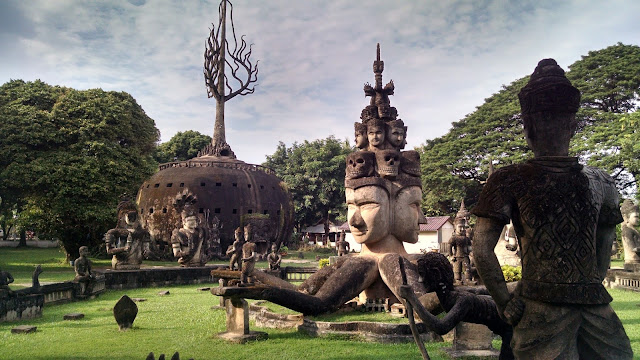Do you know about the "Secret War" the US conducted in Laos during the Vietnam War? I had no idea of the shocking scale: Laos is the most heavily bombed country in history. Here's the short version:
Laos was a French colony before WWII, part of French Indochina. After struggling against French rule Laos won full independence in 1953, just in time to become a key ideological battleground in the Cold War. Civil war began between the Western-backed Lao Royalists, neutralists, and the Communist Pathet Lao. The proxy war escalated, and in 1964 the US started bombing targets in Laos. From 1964-1973, the US extensively bombed Pathet Lao areas in the north and Ho Chi Min Trail areas in the south. "Extensively" isn't a strong enough word: 580,000 bombing missions flown and two million tons of ordinance were dropped, the equivalent of a B-52 mission every eight minutes for nine years. Massive saturation bombing against all targets, including civilian, to deny resources to the Pathet Lao. The US publicly denied involvement, thus, the "Secret War."

The lasting legacy is unexploded ordinance: UXO. Most of the bombs dropped were antipersonnel cluster bombs, which scatter hundreds of submunitions ("bombies") over a wide area. 30% failed to explode, leaving an estimated 80 MILLION unexploded bombies in Laos.
UXO is everywhere, in fields, under roads and schools, in the forests. Farmers hit them while tilling the soil, kids don't know any better and blow them up while playing with them or while hunting for scrap metal. People die driving a stake into the ground or lighting a cooking fire. 20,000 have died since the war ended, and on average one person a day is wounded or killed every day even now. It's appalling.
It's such a part of life that locals use scavenged cluster bomb cases as planters, fire pits, feeding troughs, etc.
We visited Phonsavan, the largest town on the Plain of Jars, a major strategic objective during the war. Several NGOs operate visitor centers there to educate visitors about the dangers of UXO and inform about the work they do. The Mines Advisory Group (MAG) trains Laos ordinance disposal teams and provides technical expertise. COPE (pics from Vientiane) helps rehabilitate and make prosthetics for UXO victims. The Quality of Life Association likewise provides support for UXO survivors.
The Plain of Jars itself was the site of an ancient, unknown civilization. 2,000-2,500 years ago this civilization carved hundreds of giant stone jars and left them strewn in clusters around the plain. Most likely used for funeral rituals to hold bodies until they decomposed, but local legends are colorful: the jars belong to a race of giants, or were used to brew alcohol to celebrate an ancient king's victory in battle.
We took a pink scooter around to some of the most notable jar sites. The sites are progressively more remote, and some are atop hills, others in forests, some surrounded by fields and pastures. Time has not been kind, and many have been destroyed by bandits or bombs. Bomb craters are everywhere, and MAG has marked the safe paths which are cleared of subterranean UXO.
Reminders of the UXO are everywhere.
-Peter






















































